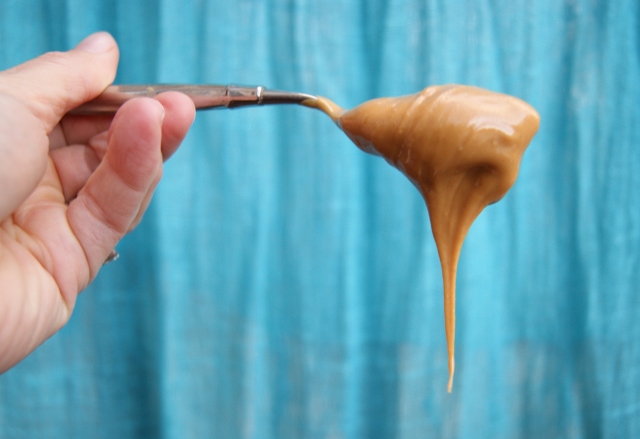This post may contain affiliate links.
 I was surfing the net last night, trying to get some dinner menu inspiration, and learned that November is National Peanut Butter Lovers month! This made me incredibly happy, because now I have a valid excuse to go nuts (pun intended!) eating the stuff. I’m pretty sure peanut butter is up there in my top 10 favorite foods list. Heck, probably in my top 3. Some of you crave chocolate, or potato chips perhaps? Not me. It’s always been peanut butter that has a must-have-some-now-or-I’ll–die-right-here-on-the-spot hold over me.
I was surfing the net last night, trying to get some dinner menu inspiration, and learned that November is National Peanut Butter Lovers month! This made me incredibly happy, because now I have a valid excuse to go nuts (pun intended!) eating the stuff. I’m pretty sure peanut butter is up there in my top 10 favorite foods list. Heck, probably in my top 3. Some of you crave chocolate, or potato chips perhaps? Not me. It’s always been peanut butter that has a must-have-some-now-or-I’ll–die-right-here-on-the-spot hold over me.
This can be a good thing or a bad thing, depending on who you ask. The National Peanut Board points out that peanut butter (the real kind…100% ground up peanuts) contains over 30 essential nutrients and phytonutrients, is cholesterol free, and helps prevent brain fatigue. It’s a relatively unprocessed real food, with plenty of other biologically active nutrients on top of the classic vitamins and minerals. But, there are a few red flags to be considered as well:
Red Flag 1: Aflatoxin
Aflatoxin is a potent human carcinogen. Peanuts grow underground, where they tend to pick up a mold called Aspergillus. Aspergillus is a source of aflatoxin, and has been associated with various diseases. According to the International Food Policy Research Institute, consuming even tiny amounts of aflatoxin may have a cumulative effect, and can potentially lead to liver damage, gastrointestinal dysfunction, decreased reproductive function, and stunted growth. However, the USDA monitors the amount of aflatoxin in our foods to ensure they don’t go over recommended limits. So, whether or not you believe peanut butter is healthy comes down to this: how much faith do you have in the USDA? There is a bright side to this. Turns out that roasting peanuts decreases aflatoxin levels by 51%, and grinding them up into peanut butter reduces the levels another 11%!
Red Flag 2: Omega-6
There is a large amount of omega 6 fatty acid linoleic acid found in peanuts, which can be problematic. We already get too much omega 6 in our diets, and that can cause trouble for our omega 3s. In a sense, the two omegas actually compete with each other to get in our cells. When we overload on omega 6s, the anti-inflammatory omega-3s can’t do the work that they need to do to fight the inflammation that omega 6s produce. So! This is a good reminder to eat peanut butter in moderation, or make sure you balance it by eating some omega 3s, too.
 We all probably grew up on good old Skippy or Jif, and some of us are probably still in the (bad) habit of keeping that stuff in the pantry today. But those commercial brands of “peanut butter” are loaded with sugars and all sorts of other no-no’s. They aren’t actually “peanut butter,” the type I’m referring to in this article….you know, take the peanuts, grind them up, and there you go….now THAT’S real peanut butter.
We all probably grew up on good old Skippy or Jif, and some of us are probably still in the (bad) habit of keeping that stuff in the pantry today. But those commercial brands of “peanut butter” are loaded with sugars and all sorts of other no-no’s. They aren’t actually “peanut butter,” the type I’m referring to in this article….you know, take the peanuts, grind them up, and there you go….now THAT’S real peanut butter.
I should also point out that peanuts aren’t technically nuts. They’re legumes, which is why some of you might have a hard time with indigestion from peanuts. You know that old rhyme, “Beans, beans the magical fruit”???…Yeah, same goes for peanuts.
In a Nutshell (ha!):
There’s good and bad when it comes to peanut butter.
The good: lots of nutrients & fiber, a good source of protein, and oh so yummy.
The bad: potential carcinogens, too much omega 6, and super dense in calories, so you probably shouldn’t do this:
While it’s probably not a wise choice to go overboard with peanut butter as a main dietary staple, it seems to be an okay choice in moderation as part of a healthful diet. Just keep it organic (peanuts tend to have high levels of pesticides) and keep it real (no sugar added).
And no, I’m sad to say, just because it has its own celebratory month, it doesn’t make Reese’s Peanut Butter cups any healthier.












Spoon butter that’s the best way, just chase it with red rice yeast. Happy Thanksgiving
LOL! Terry, you and James would get along JUST fine. But! Since real peanut butter is cholesterol free, save the red rice yeast for your Thanksgiving feast instead! 😉
And, if you like eating it right out of the jar, you’ll REALLY like this study: http://www.webmd.com/food-recipes/news/20041215/peanut-butter-packs-healthy-punch
Just for the record, I do occasionally eat healthy snacks. Stef just never takes pictures of me eating those…